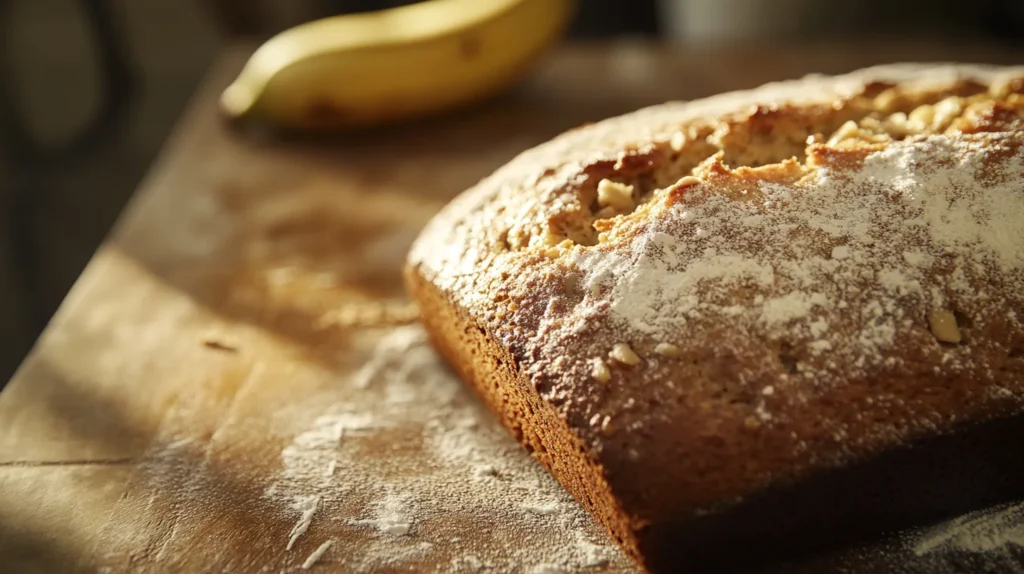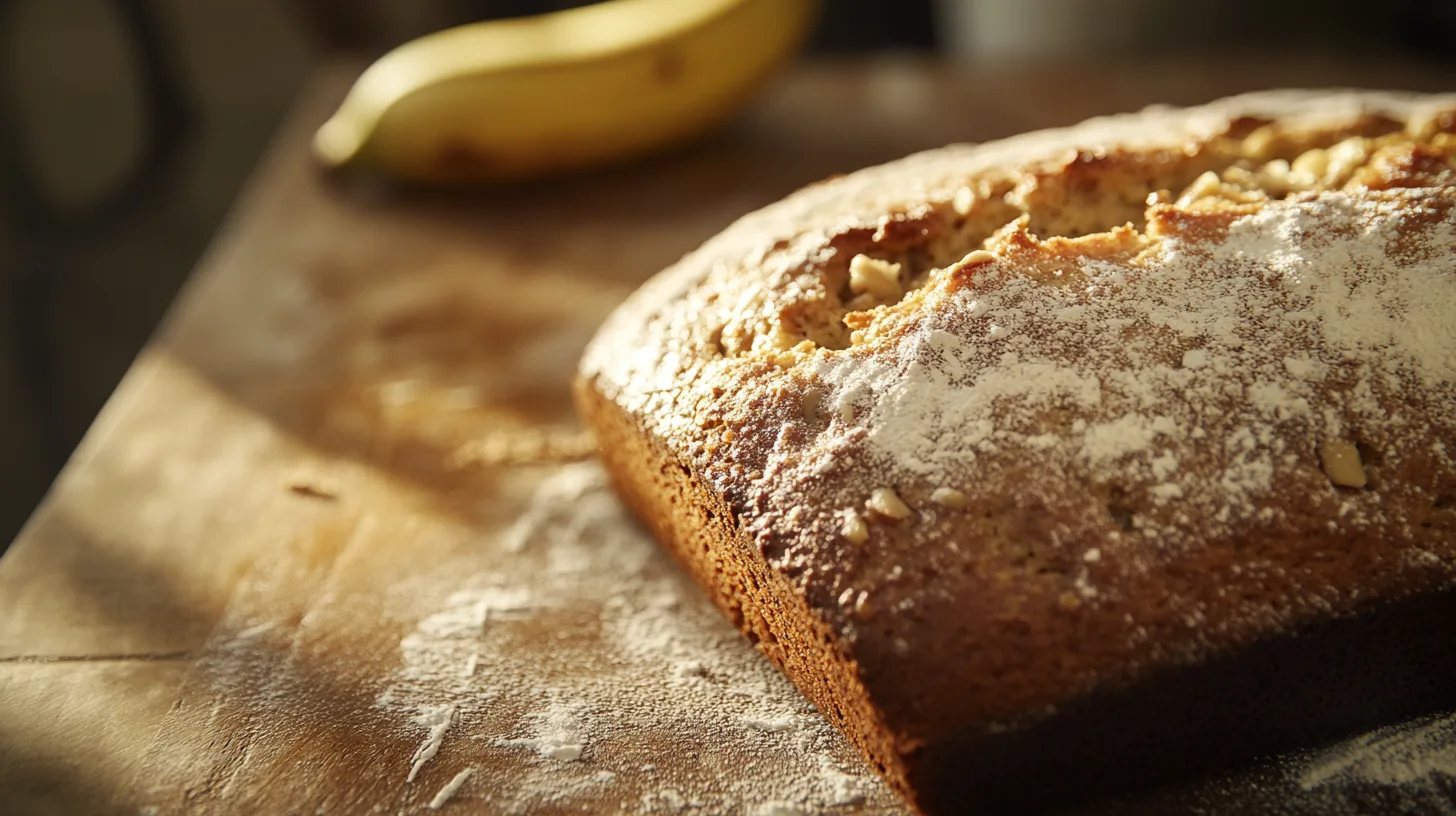The smell of banana bread baking is comforting and familiar. It’s a treat we love in our homes. But, we often wonder: is banana bread healthy, or is it just a treat we shouldn’t feel guilty about? Let’s explore the history, nutrition, and health effects of this favorite baked good together.

Key Takeaways
- Banana bread’s nutritional value depends on its ingredients and recipe.
- Bananas add natural sweetness and nutrients, but added sugars and fats can affect health.
- Using whole wheat flour and healthy fats like nuts can make banana bread healthier.
- Knowing calorie density and portion control is key to enjoying banana bread in a balanced diet.
- Changing recipes with different ingredients can make banana bread fit various diets and tastes.
The History and Evolution of Banana Bread
Banana bread has a rich history that started in the Great Depression era. It was a way to use up overripe bananas. Today, it’s a comfort food loved worldwide. Its journey shows how it adapted and became popular.
From Great Depression to Modern Comfort Food
During the Great Depression, home cooks used what they had to make food. Banana bread was born from this need. It turned cheap bananas into a tasty treat. Over years, people added their own twists to the recipe.
Traditional vs Contemporary Recipes
Banana bread’s core ingredients like ripe bananas and flour stay the same. But, the recipe has changed a lot. Old recipes used all-purpose flour, sugar, and butter. Now, we see whole-grain flours, natural sweeteners, and heart-healthy oils in modern recipes.
Banana bread has become a staple for many. It’s great for breakfast or dessert. Its lasting appeal shows it’s more than just a food; it’s a way to connect and share joy.
Basic Nutritional Profile of Banana Bread
Understanding the nutrition facts, calories, and ingredients in banana bread is key. A slice of homemade banana bread offers essential nutrients. These include macronutrients, vitamins, and minerals for a balanced diet.
The main nutrients in banana bread are carbs, fats, and proteins. A slice has about 25-30 grams of carbs, 5-10 grams of fat, and 3-5 grams of protein. The carbs come from bananas and sugars. The fats and proteins come from eggs, butter, or oil.
Banana bread also has vitamins and minerals. A slice may have small amounts of vitamin C, vitamin B6, potassium, and manganese. These nutrients are good for health and well-being.
| Nutrient | Amount per Slice |
|---|---|
| Calories | 200-250 kcal |
| Carbohydrates | 25-30 g |
| Fats | 5-10 g |
| Proteins | 3-5 g |
| Vitamin C | 2-4 mg |
| Vitamin B6 | 0.2-0.4 mg |
| Potassium | 150-300 mg |
| Manganese | 0.1-0.3 mg |
The nutrition facts and calorie content of banana bread vary. This depends on the recipe and ingredients used. The type and amount of flour, sugar, butter, or oil affect the nutritional profile.
Health Benefits of Key Ingredients
The health benefits of banana bread come from its key ingredients. Let’s explore the nutritional value and benefits of bananas, whole wheat flour, and healthy fats and proteins.
Bananas: Natural Sweetness and Nutrients
Bananas are the main ingredient in banana bread. They add natural sweetness and many essential nutrients. These yellow fruits are packed with potassium, which is good for the heart and muscles. They also have dietary fiber for better digestion.
Bananas are also a source of vitamin B6. This vitamin adds to the nutritional value of your homemade banana bread.
Whole Wheat Flour Benefits
Whole wheat flour is better than refined white flour. It has more complex carbohydrates, dietary fiber, and vitamins and minerals. It includes B vitamins, iron, and magnesium.
Using whole wheat flour in your banana bread recipe makes it more nutritious. It provides a satisfying and healthy treat.
Healthy Fats and Proteins
Many banana bread recipes include nuts, seeds, or nut butters. These add healthy fats and proteins. They make your banana bread healthier, with heart-healthy fats and plant-based proteins.
Knowing the health benefits of these ingredients helps you make better choices. This way, you can enjoy delicious and nutritious banana bread.
Is Banana Bread Healthy or Unhealthy?
Is banana bread good for you? The answer is not simple. It can be a tasty treat with some health benefits. But, it depends on the ingredients and how it’s made.
Banana bread has ripe bananas, which are full of dietary fiber, vitamins, and minerals. Adding whole wheat flour brings more fiber and complex carbohydrates. Yet, many recipes use a lot of added sugars and fats. This can make the bread less healthy.
| Nutrient | Banana Bread (1 slice) | % Daily Value |
|---|---|---|
| Calories | 250 | 12.5% |
| Total Fat | 10g | 15% |
| Saturated Fat | 6g | 30% |
| Total Carbohydrates | 37g | 12% |
| Sugars | 17g | N/A |
| Fiber | 2g | 8% |
| Protein | 4g | 8% |
To enjoy banana bread healthily, eat it in moderation. Choose recipes with less sugar and unhealthy fats. This way, you can have it as part of a healthy diet.
Hidden Sugar Content and Caloric Density
Many think banana bread is a healthy treat, but it can be high in added sugars and calories. Knowing the nutrition facts about it is key for a balanced diet.
Understanding Added Sugars
Traditional banana bread recipes often use a lot of sugar. This includes white sugar, brown sugar, or honey. These added sugars make it sweeter but also increase its calories. It’s vital to watch how much sugar is added when you eat banana bread.
Calorie Breakdown per Serving
A slice of banana bread can have 200 to 300 calories. These calories come from carbs, fats, and added sugars. Knowing this can help you choose how much banana bread to eat.
Knowing the sugar content and caloric density of banana bread helps you enjoy it wisely. It’s about eating it in moderation as part of a healthy lifestyle.
Making Your Banana Bread Healthier
If you love banana bread but want a healthier version, there are easy changes you can make. Adding whole grains, healthy fats, and nutritious alternatives can make this classic treat better for you. You won’t have to give up its tasty flavor.
Try using whole wheat flour or a mix of whole grains instead of all-purpose flour. Whole grains are full of fiber, vitamins, and minerals. They’re a healthier choice than refined flour. You can also try almond flour or oat flour for a different flavor.
For sweeteners, cut down on refined sugar and use natural options like honey, maple syrup, or applesauce. These sweeteners add sweetness and extra nutrients and antioxidants to your banana bread.
To increase healthy fats, replace some butter or oil with mashed avocado, nut butters, or Greek yogurt. These ingredients add creaminess and richness. They also bring good unsaturated fats and proteins.
Remember to add chopped walnuts, pecans, or other nuts for a nice crunch. They add healthy fats and nutrients too.
With these simple changes, you can make your banana bread healthier. It becomes a treat you can enjoy without feeling guilty.
Portion Control and Serving Suggestions
Enjoying banana bread needs careful portion control. It’s a tasty treat that can fit into a balanced diet. But, it’s crucial to not overdo it. Eating in moderation helps keep your diet healthy while still enjoying your favorite foods.
Recommended Serving Sizes
The right serving size for banana bread is a small slice, about 1 to 2 inches thick. This size lets you enjoy the taste and texture without too many calories. It’s key to stick to this size to avoid too many calories in one go.
Best Times to Enjoy Banana Bread
- As a snack: A small slice of banana bread is a great, healthy snack, especially with tea or coffee.
- Breakfast or brunch: Adding a slice to your morning can give you energy for the day.
- Occasional treat: Enjoy banana bread now and then, but remember to keep your diet balanced.
By controlling portions and eating banana bread in a balanced way, you can enjoy its flavors while staying healthy. Take your time with each bite and indulge wisely.
| Serving Size | Calories | Fat (g) | Carbohydrates (g) | Sugars (g) |
|---|---|---|---|---|
| 1-inch slice | 150 | 5 | 25 | 12 |
| 2-inch slice | 300 | 10 | 50 | 24 |
Alternative Ingredients for Dietary Restrictions
Creating a healthier banana bread is easy with the right ingredients. If you’re on a gluten-free, vegan, or low-sugar diet, there are many options. You can make your favorite banana bread recipe work for you.
Want to skip the gluten? Try using gluten-free flour blends. These can be made from brown rice, oats, or almond flour. They offer a similar texture and taste, but are gluten-free.
Vegan bakers have it easy too. You can swap eggs for mashed bananas, applesauce, or egg replacers. Use coconut oil or plant-based butter instead of regular butter or oil. Natural sweeteners like maple syrup or dates can also be used to add sweetness without extra sugar.
Related : Easy 4 Ingredient Banana Bread Ready in 30 Minutes
FAQ
Is banana bread healthy or unhealthy?
Banana bread’s healthiness depends on ingredients, portion sizes, and your diet. It can be nutritious but also high in sugar and calories if eaten too much.
What are the nutrition facts for banana bread?
A banana bread slice (about 1/10 of a loaf) has 200-300 calories. It has 5-10 grams of fat, 30-40 grams of carbs, and 3-5 grams of protein. The exact numbers vary based on ingredients.
What are the key ingredients in banana bread?
Banana bread includes ripe bananas, flour, sugar, eggs, and butter or oil. It also has baking soda or powder, and sometimes nuts or chocolate chips.
How do whole grains and healthy fats affect the healthiness of banana bread?
Using whole wheat flour makes banana bread more nutritious. It adds fiber, vitamins, and minerals. Healthy fats from nuts or avocado also boost its nutritional value.
How much added sugar is typically found in banana bread?
Banana bread’s sugar content varies by recipe. Some have a lot of sugar, while others use honey or maple syrup. Always check the nutrition label and be aware of added sugars.
How can I make my banana bread healthier?
To make healthier banana bread, try these tips: – Use whole wheat flour instead of all-purpose flour – Cut down on added sugar or use natural sweeteners – Add healthy fats like nuts, seeds, or avocado – Use more bananas to reduce sugar need – Avoid too many chocolate chips or high-calorie mix-ins
What is the recommended serving size for banana bread?
The recommended serving size is one slice, about 1/10 of a loaf. Be mindful of portion sizes to avoid overeating.
Are there any alternatives to traditional banana bread for those with dietary restrictions?
Yes, there are alternatives for dietary restrictions or preferences: – Gluten-free banana bread with gluten-free flour blends – Vegan banana bread with plant-based ingredients – Low-sugar or sugar-free banana bread with alternative sweeteners – Banana bread with nut flours or coconut flour for grain avoidance

